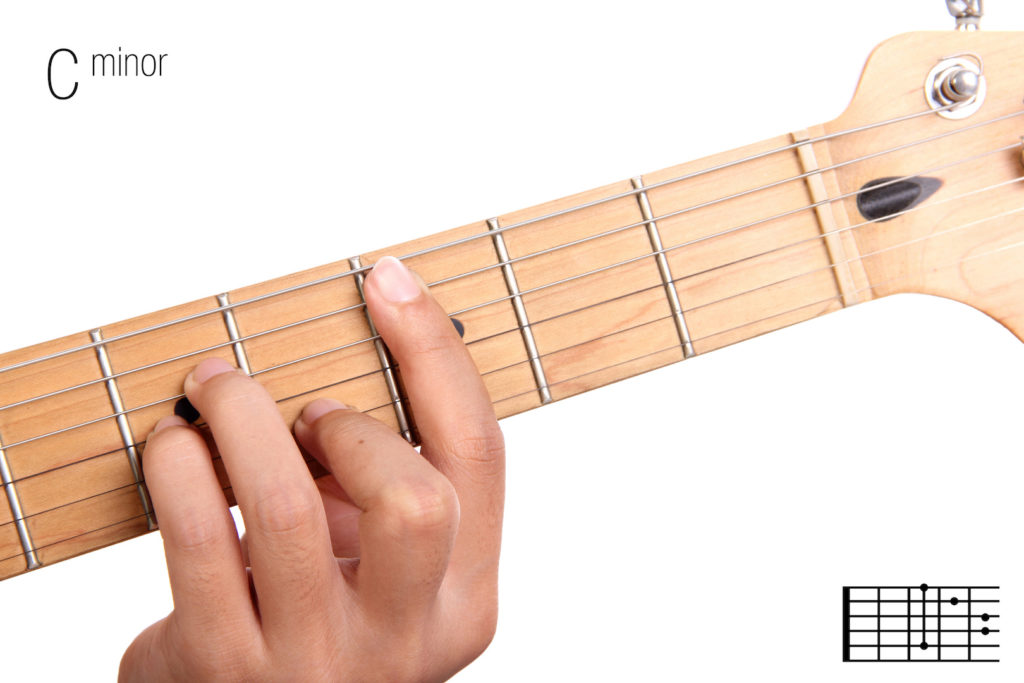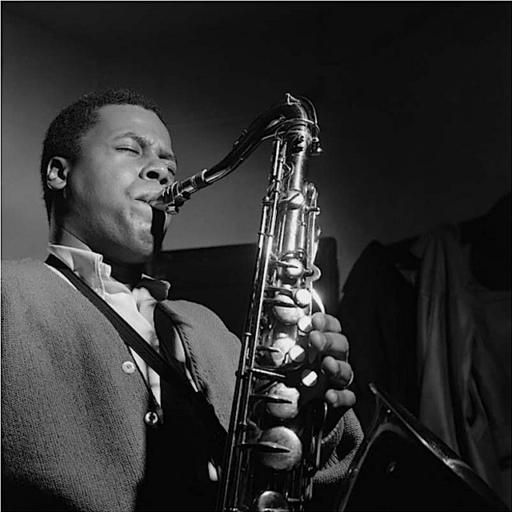Guitar Chords In C Minor: History, Chord Shapes, Minor Scale, Songs in the Key of C Minor
Author: Wanda Waterman

Table of Contents
Guitar Chords In C Minor History Lesson: The Key of the Lonesome Hero
What was Beethoven’s favourite fruit? BA-na-na-NA!
If you’re familiar with Beethoven’s fifth symphony, we hope you’ll forgive this hammy outburst, but I couldn’t help it after discovering that Beethoven’s butch, aggressive, and slightly gloomy Symphony No. 5 was written in our key-of-the-week: C Minor.

C Minor’s propensity for a mix of sadness and toughness also makes it one of the most popular keys for guitar chords in c minor blues songs.

The key of C Minor is the relative minor of the key of Eb Major. Why? Because both have the same key signature— three flats (Bb, Ab, and Eb). Relative minors are really that simple. There’s more to learn about using relative minors, but that’ll come later on in your musical journey.
When you’re ready to find out more about minor scales and how they work, read this.
The C Minor Chord Position on the Guitar
!function(e,r,d){var t,c=e.getElementsByTagName(r)[0];e.getElementById(d)||(t=e.createElement(r),t.id=d,t.src=”https://uberchord-backend.firebaseapp.com/uberchord-embed-sdk.js”,c.parentNode.insertBefore(t,c))}(document,”script”,”uberchord-jssdk”);
The key of C Minor and the guitar chords in C minor aren’t easy but they’re not among this most difficult either, and hopefully you’ve downloaded our free Uberchord app (click for free download), which can tell you exactly how you can improve a little each time you play.
Moving Those Chord Shapes Around
You may have noticed that the basic C minor chord shape is exactly the same as the basic B minor chord shape, just moved up one fret. Part of the beautiful logic of music theory is that chords and keys are so easily transposable because they all follow the same patterns.
You can use this knowledge, and your budding knowledge of music theory, to figure out new guitar chords in c minor on your own. Want to play a G major chord? Move up the basic F major chord position two frets. Want your D major to sound a little higher in pitch? Play the basic B chord position at the fifth fret. Don’t know how to play an F# major? Just move the F major chord up one fret. If the chord shape has no open strings, it’s that simple.
Theory and Practice: The Pattern of the C Minor Scale Explained
Just in case you’re a newcomer to this site, let’s take a quick look at the differences between a major scale and a minor scale.
Unlike major keys, the tones in a minor key arrive in this sequence:
whole tone, half tone, whole tone, whole tone, half-tone, whole tone, whole tone
In other words, the second and the fifth positions in the scale are just half tones above their preceding notes, and all the other notes are whole tones above their previous notes. All natural minor keys follow this same pattern.
In the key of C Minor the notes are C, D, Eb, F, G, Ab, and Bb.
Below is the C Minor scale, with C at its root and another C, an octave higher, at its summit.

Try sounding it out on your guitar by playing it according to this tablature:
Playing scales on your guitar is a whole lot easier after you memorise your guitar’s fretboard notes. Here is a secret technique used by many pro guitarists around the world to learn the fretboard.
Harmonic Minors
This week we’d like to introduce a new musical concept in the realm of minor keys: harmonic minor keys. Skip it for now if you like, but it’s a simple concept and may help you to avoid confusion later.
A harmonic minor key is like a natural minor (the kind of minor key we’ve been studying so far) except for one tiny difference: the seventh note is raised a half tone. In the key of C Minor, this would raise the Bb to a B. That’s it!
All Of The Guitar Chords In C Minor
To complicate things a little, not only are the sequences of tones different in minor keys, which chords are major and minor is also different than the pattern used in major keys. In minor keys the sequence is as follows:
1st chord: minor
2nd chord: diminished
3rd chord: major
4th chord: minor
5th chord: minor
6th chord: major
7th chord: major
The C Minor chord, which forms the root of the C Minor scale, is made up of the notes C, Eb, and G— the first, third, and fifth notes of the key of C Minor. On the guitar, using the C Minor chord shape shown in the diagram, these notes arrive in this order: Mute, C, G, C, Eb, G.
Why does this chord sound so different from the C Major chord? The only difference is one string; in the C Major chord the Eb becomes E (because that’s what C Major’s key signature dictates), and that’s all it takes to turn a cheerful C major chord into a melancholy C minor.
(The best musical education involves training both the ear and the mind. Learning music theory will help you to become a better musician and give you the comfort of knowing what it all means. To this end our blog offers a helpful set of music theory articles to give you some direction.)
!function(e,r,d){var t,c=e.getElementsByTagName(r)[0];e.getElementById(d)||(t=e.createElement(r),t.id=d,t.src=”https://uberchord-backend.firebaseapp.com/uberchord-embed-sdk.js”,c.parentNode.insertBefore(t,c))}(document,”script”,”uberchord-jssdk”);
“Loverman,” by Nick Cave and the Bad Seeds (just keep repeating these three chords for verses and chorus)
If you were to use every guitar chord in C Minor, these would be the chords you’d use:
C Minor, D diminished, Eb major, F minor, G minor, Ab major, and Bb major
The C, F, and G chords are minor because in the natural minor scale (unlike the major scale) the chords at the first fourth, and fifth positions of the key are minor.
The D is a diminished chord because in the key of C Minor it sits in second place, and in minor keys second place chords are diminished.
As in the major keys, the fifth chord— G minor in this case— can also be played as a Gminor7. Because it sits at the fifth position in the key of C Minor, it has the privilege of being the chord announcing the ending of the chord progression, if not the end of the song itself, and is generally followed by the root chord (C minor in this case).
Adding the seventh note of the key of G Minor (F) to the G Minor chord, creating a Gminor7, makes the G minor chord sound like it’s moving the action ahead, pushing on to the root chord (C minor) that usually comes next in the chord progression.
Check out our previous post on understanding and playing 7th chords and, don’t miss the series on learning and understanding music theory.
Chord Progressions in C Minor
You can develop your musical skills by taking a little time to play through the progressions below, getting your ear used to how these chords, depending on their order and context, create the sounds of beginning, rising, falling, and ending.
Once again, here are the guitar chords in C Minor: C Minor, D diminished, Eb major, F minor, G minor, Ab major, and Bb major. But you can’t just mash all of these together (unless you’re Pere Ubu, in which case you don’t want to sound harmonious). Most of the time chords have to come in an order that’s pleasing to the ear, which is why we have chord progressions.
Unless you live in Borneo, most of the songs you hear each day are composed of combinations of the chord progressions listed below. As you play them and get used to their sound, you’ll probably recognise them and be reminded of particular songs.
Important: By far the most common chord progression for folk, classical, jazz standards, country, and pop songs is loosely based on this progression: I, IV, V, I (that is, on the first, fourth, and fifth chords in each key). In the key of C Minor this becomes C minor, F minor, and G minor (or G minor 7). Try playing these chords in this order:
C minor—F minor—G minor (or G minor 7)—C minor.
Repeat this progression a few times. Do you hear how even in this short progression the music has a clear beginning, middle, and end, especially if you use G minor 7?
Now practice playing through the following progressions, getting a feel for the musical messages they carry. If one progression sounds a little awkward and unmusical, just move on to the next.
- C minor – G minor (7) – Ab major – F minor
- C minor – Ab major – F minor – G minor (7)
- C minor – G minor (7) – Ab major – Eb major – F minor – C minor – F minor – G minor (7)
- Blues: C minor – C minor – C minor – C minor – F minor – F minor – C minor – C minor – G minor (7) – G minor (7) – C minor – C minor
- D dim – F minor – G minor (7)
- C minor – F minor – G minor (7) – F minor
- G minor (7) – F minor – C minor
- Ab major – F minor – C minor – G minor (7)
- Ab major – G minor (7) – Ab major – G minor (7)
Just A Few Great Songs in the Key of C Minor
The guitar chords in C Minor are sometimes bluesy, sometimes sad, sometimes aggressive, and sometimes all three.
It can express the powerful resentment of unrequited love, as in Adele’s “Rolling in the Deep.”
It can be Survivors “Eye of the Tiger”
It can be Bon Jovi’s “You Give Love A Bad Name”.
Think of any guitar chords in C Minor as that large, grumpy friend you always hope shows up to defend you when you’re cornered. Get to know it. You never know what it will get you through.
And if you haven’t downloaded the Uberchord app yet, here are five great reasons why you should! We also have articles that cover other theory topics like the notes in f chords, the key of am guitar, as well as a discussion on the key g guitar. If you’ve made it this far into this article, then chances are that you’re just as curious about music theory as we are! Please check them out or search our blog for any other topic you may need info on.
Sources:
http://www.pianoscales.org/songs-by-key.html
Rita Steblin (1996) A History of Key Characteristics in the Eighteenth and Early
Nineteenth Centuries, University of Rochester Press, p. 123
D. Mar (1981). Anatomy of the Orchestra, University of California Press, p. 349
Emotions of the Musical Keys
The 10 Most Used Chord Progressions in Pop and Rock and Roll









No comments yet - be the first.